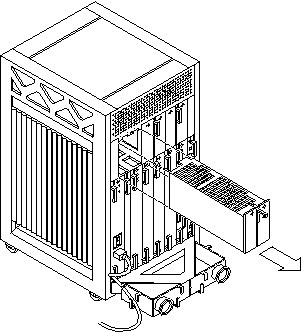Power/Cooling Module (PCM)
The power/cooling module (PCM, see Figure 7-6) provides power for two boards. The PCM also supplies cooling air to the board slots, so in normal operation each board must be next to a working PCM.
Figure 7-6 PCM

The PCM incorporates an AC inrush limit circuit and two precharge inputs (3.3V and 5V) that enable it to be hot-pluggable into a live centerplane.
Within a system all PCMs operate in a parallel redundant mode, sharing 2.0V, 3.3V, and 5V output currents. The shared 5V output also includes the 5V output of a peripheral power supply.
Requirements for Redundant Power
If a DC supply in a PCM fails, the system boards will continue to be powered and cooled by the other power supplies if sufficient redundancy (an additional power supply) is present.
For example, if an Enterprise 3500 system needs a minimum of two PCMs and three are present, then the system has redundancy. See Table 7-3.
Note -
The presence of an additional (extra) PCM in the system provides redundancy and allows hot-plug of PCMs.
Table 7-3 Minimum and Redundant Working Power Supplies Required to Power Active Boards
|
|
Enterprise 3500 System |
|
|---|---|---|
|
Number of Boards |
Minimum Number of Working PCMs |
Redundant Working PCMs (Hot-Pluggable) |
|
1-2 |
1 |
2 |
|
3-4 |
2 |
3 |
|
5 |
3 |
No redundancy |
Note -
When all five board slots are populated, there is no redundancy because of the two PCMs per board rule.
Failed power supplies must be replaced as soon as practical. Otherwise, the Enterprise 3500 system will lose its redundancy and result in an outage at the next PCM failure.
Cooling Requirements
Note -
In the Enterprise 3500 system, all boards must be adjacent to a PCM. The fans in the PCM cool the boards. The minimum configuration is one PCM for every two adjacent boards.
The PCMs incorporate redundant bulk fan power so that the fans continue to operate in a failed power supply via the redundant fan power from the peripheral power supply.
Note -
A PCM or an auxiliary fan tray must be working in PCM slot 5. The fans cool the peripheral power supply/AC input.
Troubleshooting a PCM
A green LED is lit on the power supply when it is operational. When a PCM fails, a yellow LED is lit on the PCM.
You will see a message similar to the following example on your system console when a PCM fails:
WARNING: Core Power Supply 3 Failing WARNING: Redundant power lost
See Table 10-6 for more information.
Replacing a PCM
Do not replace a PCM while the system is in the low power mode. Remove and replace the PCM only in a running system. Replacing a PCM during low power mode will cause the system to power up immediately and result in a severe overload condition for that PCM (the other PCMs will remain in the low power mode). The system is in the low power mode if the front panel and board LEDs are all off while the yellow LEDs are lit on the power supplies.
Replace the PCM immediately or risk overheating the board(s) cooled by the fans in that power supply.
Remember the following rules for hot-plug replacement of a PCM:
-
The peripheral power supply/AC (PPS0) must be fully operational (to provide precharge current).
-
There must be a redundancy of electrical power (see Table 7-3) in the system.
-
Use the prtdiag (1M) command to determine if precharge current is present.
-
Release the power supply from the system chassis by inserting a Phillips #1 screwdriver into each quarter-turn access slot and then turning to the unlocked position. See Figure 7-7.
Figure 7-7 Quarter-turn Access Slots

-
Pull the end of the extraction lever outward to release the power supply from the centerplane.
-
Pull out the power supply. See Figure 7-8.
You will see a message similar to the following example on your system console:
NOTICE: Core Power Supply 5 Removed
Figure 7-8 Replacing a PCM in the Enterprise 3500 System

-
Carefully insert the replacement power supply in the proper slot.
-
Orient the PCM with the extraction lever on the outside edge of the Enterprise 3500 system.
-
Verify that the arrows in the quarter-turn access slots are turned to the unlocked position.
-
Ensure that the extraction lever is in the outward, unlocked position.
The power supply will not seat fully unless the lever is in the unlocked position.
 Caution -
Caution - DO NOT FORCE the power supply into a slot. This can cause damage to the power supply and system.
The power supply should insert and seat smoothly. If it binds, remove it, and inspect the slot for any obvious obstructions. Do not damage the springfingers at the bottom of the power supply.
-
-
Slide the power supply toward the centerplane, then use the extraction lever to seat the power supply. See Figure 7-8.
Swing the lever inward to the locked position. Do not press on the front panel of the power supply to seat it--doing so will damage the connector pins.
-
Lock the power supply to the system chassis by inserting a Phillips #1 screwdriver into each quarter-turn access slot and then turning to the locked position. See Figure 7-7.
-
Check to be sure the green LED on the PCM is lit.
If the green LED is not lit, the power supply is not seated properly. Repeat Step 5 to Step 8. If the green LED is still not lit, see Table 10-6 for more information.
If the green LED is lit, you will see a message similar to the following example on your system console:
NOTICE: Core Power Supply 5 Installed NOTICE: Core Power Supply 5 OK NOTICE: Redundant power available
- © 2010, Oracle Corporation and/or its affiliates
